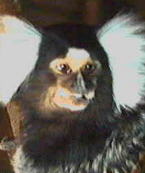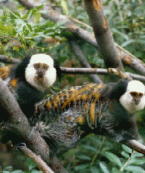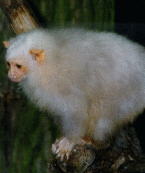Marmosets (Callithrix/Cebuella) are small monkeys that live in trees. Marmosets have a very distinctive smell, they actually use their scent glands to communicate. This makes it possible to identify themselves to each other. They have been kept by people as pets for several years but (unfortunately) a lot of the common marmosets are also used for medical research. On this site you will find all the information you need to know about keeping marmosets as pets.
 Common Marmoset (c) Johan Mommens |
 Pygmy Marmoset (c) Ivan Crab |
 Geoffroy’s Marmoset (c) Ivan Crab |
 Silvery Marmoset (c) Ivan Crab |
| Marmoset Care Sheets
|
Marmoset Species:
|
The feeding of Primates
December 29, 2011 8:34 pm
By Ivan Crab
During recent years, the feeding of PRIMATES has undergone significant changes, as more has been discovered about their nutritional needs. The pets market of today provide different “monkey pellets” , pelleted diets they are usually well balanced but they can not by given at the expense of a varied diet.
It is no coincidence that when breeding began in earnest during the 1950s, it was the OLD WORLD species which reproduced most successfully in collections. This is because MONKEYS such as the MACACA species were best-suited to thrive and breed on a diet composed of little more than vegetables and fruits.
The needs of other species are more complex. Certainly in captivity they thrive when offered a diet which contains a relatively high proportion of vegetables and fruit. more...
Posted in baboon, bush baby, capuchin, feeding, gibbon, lemur, macaque, marmoset, owl monkeys, squirrel monkeys, tamarin
Marmosets and Squirrel Monkeys don’t mix!
October 12, 2011 6:24 pm
It is known among big breeders and it’s time that you know it too. Marmosets, Tamarins or Owl monkeys cannot be put together with squirrel monkeys.
Squirrel monkeys are the carrier of the herpes saimiri virus, which is deadly for marmosets, tamarins and owl monkeys. Once they are infected, death can occur within 24 hours. A squirrel monkey who carries herpes saimiri, doesn’t show any symptoms and unfortunately testing for this virus are not conclusive.
A big breeder told me once that he lost a whole colony of marmosets within a few days caused by this virus although his squirrels and marmosets were housed far from each other.
The problem is that you cannot see the virus. It can be spread by handling the food, dishes or toys touched by a squirrel monkey. Just walking from one cage to the other can cause the infection already. more...
Posted in marmoset, owl monkeys, squirrel monkeys, tamarin
How it all started…
January 1, 2001 6:14 am
About 15 years ago I walked into an exotic pet store that specialized in lizards. I used to go there every week due to my interest in lizards. One day I noticed a small cage, the size of a hamster cage, on a shelf which caught my attention. Little that I know that this was about the open up a whole new world for me. The world of primate ownership! I wasn’t sure what I saw so I asked the store owner. A few minutes later I found that this was a common marmoset. I went straight to the bank, took the money of my account and bought myself the cutest critter I ever saw. And so the adventure began… more...